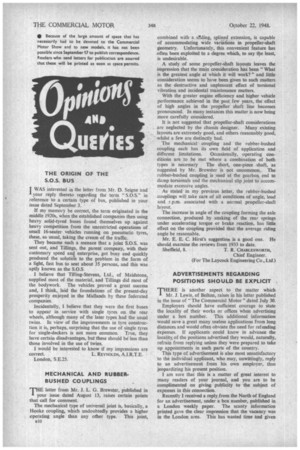MECHANICAL AND RUBBERBUSHED COUPLINGS
Page 44

If you've noticed an error in this article please click here to report it so we can fix it.
THE letter from Mr. J. L. G. Brewster, published in I your issue dated August 13, raises certain points that call for comment.
The mechanical type of universal joint is, basically, a Hooke coupling, which undoubtedly provides a higher operating angle than any other type. This joint, ti 10
combined with a sl!ding, splined extension, is capable of accommodating wide variations in propeller-shaft geometry. Unfortunately, this convenient feature has often been exploited to a degree which, to say the least, is undesirable.
A study of some propeller-shaft layouts leaves the impression that the main consideration has been "What is the greatest angle at which it will work?" and little consideration seems to have been given to such matters as the destructive and unpleasant effect of torsional vibration and incidental maintenance matters.
With the greater engine efficiency and higher vehicle performance achieved in the past few years, the effect of high angles in the propeller shaft line becomes pronounced. In many instances this matter is now being more carefully considered.
It is not suggested that propeller-shaft considerations are neglected by the chassis designer. Many existing layouts are extremely good, and others reasonably good, whilst a few are distinctly bad.
The mechanical coupling and the rubber-bushed coupling each has its own field of application and different limitations. Occasionally, operating conditions are to be met where a combination of both
types is necessary The short, one-piece shaft, as suggested by Mr. Brewster is not uncommon. The rubber-bushed coupling is used at the gearbox end to damp torsionals and the mechanical slip joint to accommodate excessive angles.
As stated in my previous letter, the rubber-bushed couplings will take care of all conditions of angle, load and r.p.m. associated with a normal propeller-shaft layout.
The increase in angle of the coupling forming the axle connection, produced by snaking of the rear springs under accelerating torque or brake reaction, has little effect on the coupling provided that the average riding angle be reasonable.
Mr. E. E. C. Hirst's suggestion is a good one. He should examine the reviews from 1933 to date.
Sheffield, 8. T. R. CHARLESWORTH,
Chief Engineer.
(For The Laycock Engineering Co., Ltd.)




















































































